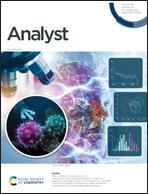Fabrication of a honeycomb-like bimetallic SERS substrate for the detection of triphenyltin chloride†
Abstract
Triphenyltin chloride (TPhT) is an organotin compound that causes intensive toxicological risk to the environment and humans. A detection method with high sensitivity and stability is therefore desired to better detect TPhT. In this study, a novel SERS substrate was prepared by sputtering an ultra-thin Au layer on a honeycomb-like silver nanoarray fabricated via the nanosphere lithography method. The ultra-thin Au layer was formed by sputtering the intermittent Au nanoparticles on the silver nanoarray, resulting in bimetallic coupling with dramatically increased hotspots and extremely high SERS enhancement with an analytical enhancement factor (AEF) of 6.08 × 109 using Rhodamine 6G (R6G) as the probe molecule. Based on density functional theory (DFT) simulations, the Raman characteristic peaks of TPhT at 999 cm−1 and 655 cm−1 were selected for TPhT detection. The AEF of the SERS substrate HC5-AgAu was calculated to be 3.38 × 106 with the detection concentration of TPhT down to 10−10 M. The as-prepared honeycomb-like silver–gold bimetallic SERS substrate demonstrated great stability and sensitivity for TPhT detection, which might also be applied in monitoring many other environmental pollutants.



 Please wait while we load your content...
Please wait while we load your content...